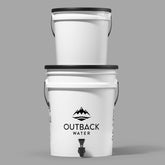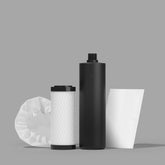Quiz 5 - Water Quality Questions
Outback Water offers a monthly quiz to test your knowledge regarding facts about water and water related issues. Find out how well versed you are in your knowledge of one of the single most important topics regarding our survival - Water. (The "water treatment industry" has some language 'all its own' so feel free to use our Glossary of Terms for help with unfamiliar words.) The answers to each quiz are listed at the bottom of the page.
QUIZ #5 - WATER QUALITY QUESTIONS
1. Water that has moved underground has underground natural filtration, therefore its purity is guaranteed. (True or False)
2. The reason(s) to sample and analyze a household's water is/are to:
a) Determine the kind of water treatment
b) Size the necessary treatment equipment
c) Meet local requirements and laws
d) Assess the cause of water problems
e) All of the above
3. The U.S. Environmental Protection Agency (EPA) has established the definition of "good water quality". (True or False)
4. The determination of whether special chemical or biological water sample tests are needed can be most aided by:
a) Water hardness
b) The yield capacity of the water quality
c) A sanitary survey
d) The time of year
e) All of the above
5. The single most important consideration about any drinking water supply is its freedom from:
a) Iron staining
b) Disease-producing organisms
c) Total dissolved solids
d) Chlorides
6. Following are types of microorganisms that can be pathogenic (disease producing) in drinking water:
a) Bacteria
b) Protozoa
c) Viruses
d) a and c
e) All of the above
7. Coliform bacteria:
a) Grow in the intestines of people and warm blooded animals
b) Usually cause diseases
c) Respond to water treatment differently than do most other pathogens
d) Exist only in water that contains pathogens
e) All of the above
8. Turbidity or water clarity testing can provide information about the bacteriological safety of water. (True or False)
9. Running or moving water purifies itself to “drinking water quality” after flowing a specified distance. (True or False)
10. A well or spring groundwater source, located downhill of a septic tank, may have increased susceptibility to pollution. (True or False)
Answers to Water Quality - Quiz #5
1. False: Groundwater does typically undergo a degree of natural filtration that tends to remove particles in suspension, including microorganisms. In addition, the bacteriological quality of groundwater often improves during storage in aquifers because conditions there are usually unfavorable for bacterial survival. However, dissolved minerals from subsurface materials can make some well or spring water unsafe to drink, or at least aesthetically displeasing.
2. E: Homeowners often complain that their water contains bad taste, odor or color; corrodes or scales plumbing; stains laundry and sinks; is dirty; or even causes illness to family members. Water sampling and analysis can ascertain the cause of many of these complaints and problems. In addition, a thorough knowledge of water quality helps to accurately select the kind of treatment and size of equipment necessary to provide safe and palatable water. Also, health regulations may require that household water supply systems meet minimum standards for physical, chemical or biological constituents.
3. False: The EPA defines water quality that meets regulations of the Safe Drinking Water Act. However, any definitions of good quality water or acceptable water quality must include the bias of the individual consumer and the intended use. Water that meets EPA safe drinking water limits may not be fully acceptable for washing clothes and dishes, it may not be consumed with pleasure because of the objectionable tastes, odors or color, or home owner may not be entirely content with residual contaminants below the EPS maximum contaminant level.
4. C: A sanitary survey locates potential sources of water quality degradation in and around the point of the water supply. On-site and nearby septic tanks, for example, should call for coliform and nitrate analyses. Agricultural practices may indicate specifying pesticides and herbicides scans. Older plumbing and solder should draw attention to lead analysis. Nearby landfills or city dumps may point to the need for heavy metal and complete drinking water MCL testing. Gas stations and industrial complexes that can impact on the water source from gas stations and industrial complexes can trigger volatile organic chemical and/or synthetic organic chemical analyses.
5. B: Regardless of its source, water can be susceptible to microbiological contamination at any time. For this reason, it is necessary to sample water periodically and to have it analyzed for health-related bacteriological contamination.
6. E: Bacteriologic and protozoic pathogens are known to cause typhoid fever, cholera, dysentery and various types of gastroenteritis, such as salmonellosis, giardiasis and cryptosporidiosis. Viruses account for scores of human enteric maladies, including polio, infectious hepatitis and various forms of gastroenteritis.
7. A: The presence of coliform in water, especially E.coli, is presumptive evidence of sewage and fecal contamination. Coliform bacteria themselves are usually harmless, and while it is true that water can contain coliform bacteria and still not contain any pathogenic organisms, it is certainly not wise to assume that people drinking such water will remain healthy. Evidence shows that pathogenic bacteria, such as those causing typhoid, paratyphoid, cholera, and bacillary dysentery, respond to water treatment in a manner similar to that of coliform, however exceptions to this are the protozoan cysts Giardia and Cryptosporidium, which cannot be destroyed as easily as coliform but can easily be removed by fine micron filtration.
8. False: Neither turbidity nor water clarity alone provide information about the bacteriological safety of water. Only laboratory microbiological testing (and perhaps additional chemical and radiochemical testing) can determine whether or not the water is safe to drink.
9. False: Running water in an open conduit or stream bed does not guarantee purity or safety. In fact, the greater likelihood of physical and bacteriological contamination of surface water makes it generally unsafe for household use unless reliable filtration and disinfection treatment is provided.
10. True: Because the direction of groundwater flow typically approximates that of the land surface water flow, it is usually desirable to locate a well so that the normal movement of water flow carries contamination and surface water away from the well. Springs can become even more susceptible to contamination when sources of pollution are located on higher adjacent land because a spring is often representative of groundwater that is closer to the Earth's surface.
- Choosing a selection results in a full page refresh.





